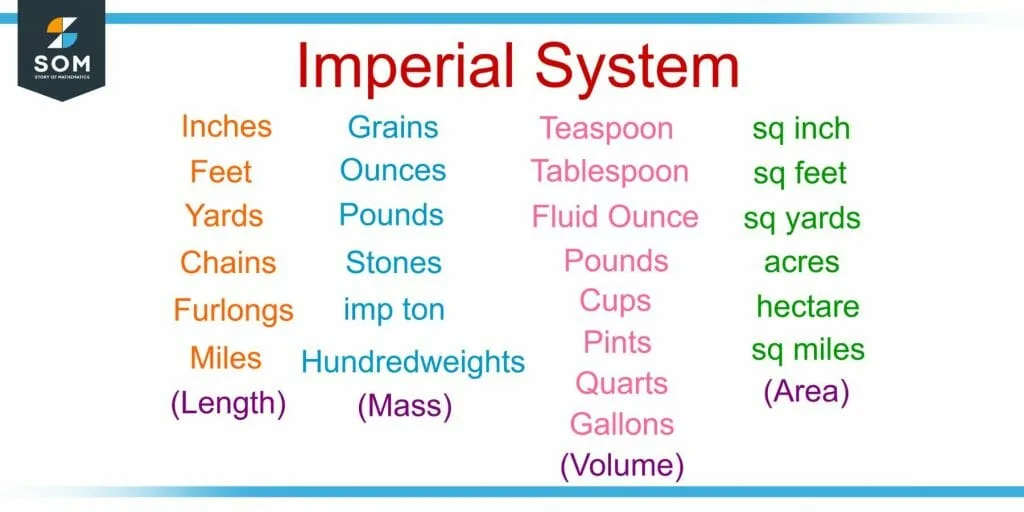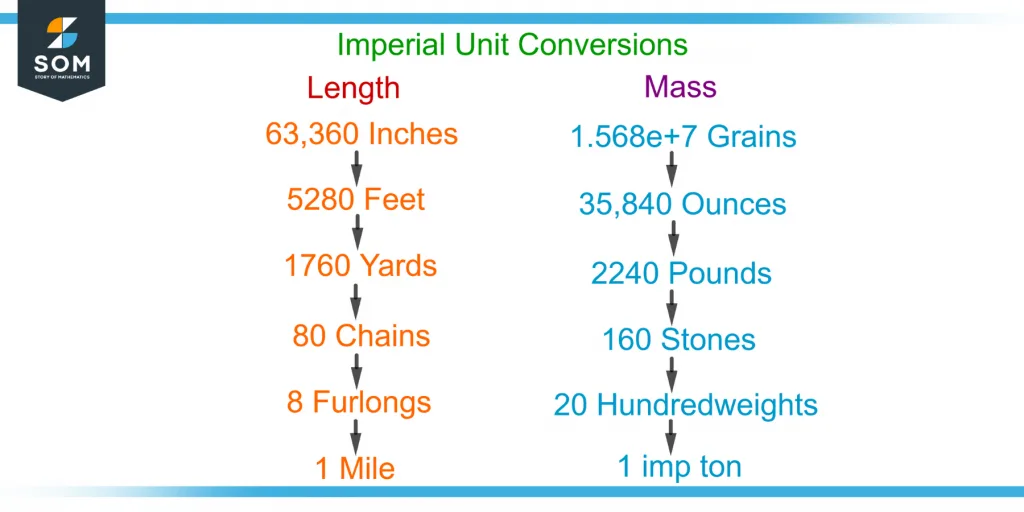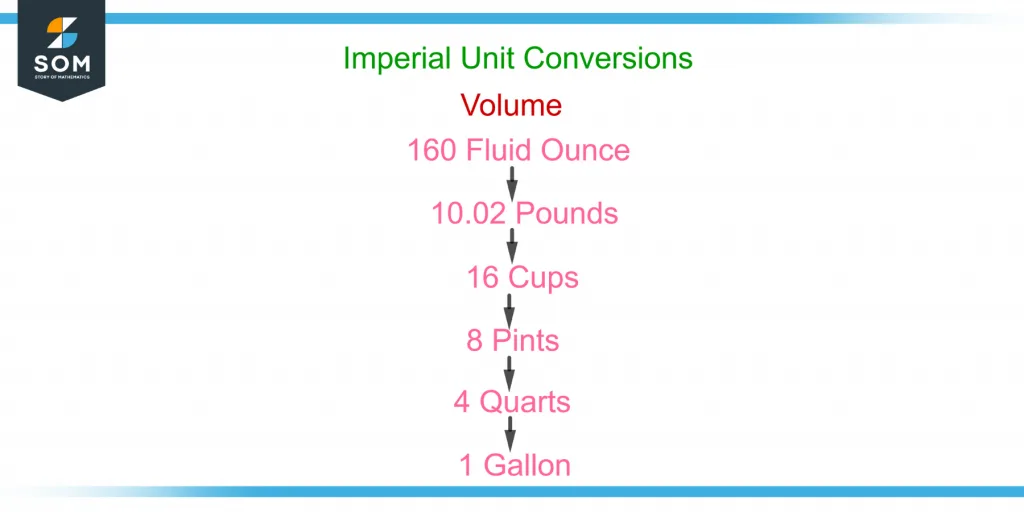JUMP TO TOPIC
Imperial System|Definition & Meaning
Definition
The imperial system is a system of units and measures developed in England, although it has been replaced by the metric system in almost all countries. Except for the volume measurements (all imperial volume units are larger than their US counterparts), all other units are exactly the same as in the US standard units.
Figure 1 shows all the imperial system units of length, mass, volume, and area.

Figure 1 – Demonstration of the Units of Length, Mass, Volume, and Area in the Imperial System
History
The imperial system of units, also known as the British imperial system, was adopted in 1824 in Great Britain. It was replaced by the Metric system in 1965, which France introduced in the 1790s.
The imperial measurement system paved the way for the United States‘ standard measurement system. The prefix “imp” with the unit denotes the imperial unit, and “US” denotes the US standard unit.
Many evolutions took place in the imperial system in the Celtic, Roman, Anglo-Saxon, and Middle East eras.
The values of the imperial units such as gallon, foot, and pound varied with time, trade, place, and product specifications. The variations of the gallon, such as corn, ale, and wine, were abolished, and a single imperial gallon equal to ten pounds was introduced.
The rod and chaldron were also terminated.
The troy pound and the yard were the basic imperial units restricted to weigh metal, drugs, and jewels. The imperial pound and yard were equal to 0.45359237 kilograms and 0.9144 meters, respectively.
Imperial units are converted to metric units, which are used mostly in mathematical problems. The seven base units of the metric system are meters(m), kilograms(kg), seconds(s), Kelvins(K), candela(cd), mole(mol), and ampere(A).
The imperial units of length, area, weight, and volume are discussed below.
Length
The measure of distance is known as the length. The unit of length is a base unit from which other units are derived in many unit measurement systems, including the imperial system. The System International unit of length is meters, denoted by “m.” The following imperial units are used to measure length.
Inches
An inch, abbreviated as “in,” is the smallest unit of length. It is equal to 0.0254 meters. So:
1 inch = 0.0254 m
Dividing 0.0254 into both sides in the above equation gives:
1 m = 39.3701 inches
One inch is equal to the other imperial units of length as follows:
1 inch = 1/12 feet
1 inch = 1/36 yards
1 inch = 0.00126 chains
1 inch = 1/63,360 miles
Feet
The unit of length greater than “inches” is “feet,” as one foot equals twelve inches as:
1 foot = 12 inches
It is abbreviated as “ft” and related to the other imperial units of length as:
1 foot = 1/3 yards
1 foot = 1/66 chains
1 foot = 1/660 furlongs
1 foot = 1/5280 miles
For example, the average length of a truck is approximately 20 feet. Also, one meter equals 3.28084 meters, so:
1 foot = 0.3048 meters
Yards
Three feet make one yard; hence yard is a greater unit than the feet, so:
1 yard = 3 feet
It is abbreviated as “yd” and related to the other imperial units as:
1 yd = 36 inches
1 yd = 0.0455 chain
1 yd = 1/220 furlongs
1 yd = 1/1760 miles
For example, the length of a mattress is almost 3 yards. One yard is equal to the metric unit of length as:
1 yd = 0.9144 m
Chains
One imperial chain is equal to 22 yards, so:
1 chain = 22 yards
Additionally, we have:
1 chain = 4 rods
1 chain = 66 feet
1 chain = 22 yards
1 chain = 1/10 furlongs
1 chain = 1/80 miles
In the metric system, one chain equals 20.1168 meters.
Furlongs
A furlong is used to measure distance in the US and imperial units. One furlong is equal to 10 imperial chains, so:
1 furlong = 10 chains
It is related to the other imperial units as:
1 furlong = 40 rods
1 furlong = 660 feet
1 furlong = 220 yards
1 furlong = 40 rods
1 furlong = 1/8 mile
In SI units, one furlong equals 201.168 meters.
Miles
A mile is the largest imperial unit of length used to measure long distances. A mile consists of 1760 yards. Also, it is related to the other imperial units as:
1 mile = 63,360 inches
1 mile = 5280 feet
1 mile = 1760 yards
1 mile = 80 chains
1 mile = 8 furlongs
Also, in SI units, one mile equals 1,609.344 meters.
Mass
Most people use the term “weight” for “mass” because the scales which measure mass are called “weighing scales,” but both are two different quantities.
Mass is the amount of matter composed within an object. The metric unit of mass is the kilogram (kg). Weight is defined as the mass of an object due to gravitational pull. It is the force experienced by the object due to gravitational acceleration.
The imperial units in which weight or what should be called mass is measured are as follows:
Grains
The grain is the smallest imperial unit of mass. One milligram consists of 0.0154 grains.
Ounces
One ounce consists of 437.5 grains. An ounce abbreviated as “oz” is different from a fluid ounce. It is related to the other imperial units as follows:
1 oz = 1/16 pound
1 oz = 1/224 stone
1 oz = 1/1792 hundredweight
1 oz = 1/35,840 imp ton
Pounds
A pound abbreviated as “lb” is also known as pound-mass. Sixteen ounces make one pound, so:
1 lb = 16 oz
A pound is used to measure the weight of a person, object, etc. It is related to the other imperial units as:
1 lb = 7000 grains
1 lb = 1/14 stone
1 lb = 1/112 hundredweight
1 lb = 1/2240 imp ton
Stones
Fourteen pounds makes one imperial stone, so:
1 stone = 14 pounds
It is related to the other imperial units as:
1 stone = 98,000 grains
1 stone = 224 ounces
1 stone = 1/8 hundredweight
1 stone = 1/160 imp ton
Hundredweights
Eight stones make one hundredweight. A hundredweight is abbreviated as “cwt” and is related to the other imperial units of mass as:
1 cwt = 7,84,000 grains
1 cwt = 1792 oz
1 cwt = 112 lb
1 cwt = 8 stones
1 cwt = 1/20 imp ton
Imperial Tons
One imperial ton, abbreviated as “imp t,” is greater than one US ton, which is why the imperial ton is sometimes referred to as the long ton (UK) and the US ton as the short ton. The imp ton is related to the other imperial units as follows:
1 imp ton = 35,840 oz
1 imp ton = 2240 lb
1 imp ton = 160 stones
1 imp ton = 20 hundredweights
Figure 2 shows the imperial unit conversions for length and mass.

Figure 2 – Imperial Unit Conversions for Length and Mass
Area
A plane region’s area is the measurement of the size of a region on the plane surface. The SI unit of area is meter squared(m2). For example, the area of a circle is πr2. The following units of area are used in the imperial system.
Square Inches
One square inch is equal to 6.4516 cm2. A square inch is abbreviated as in2 or “sq inch.” Also:
0.155 in2 = 100 mm2 = 1 cm2
Square Feet
One square foot equals 0.0929 m2. A square foot is abbreviated as ft2 or “sq foot.” Also:
1 ft2 = 144 in2
Square Yards
One square yard equals 0.8361 m2. It is abbreviated as yd2 or “sq yd.” Also:
1 yd2 = 9 ft2
1 yd2 = 1296 in2
To convert square meters into square yards:
1 sq meter = 1.1960 yd2 = 10,000 cm2
Acres
One acre is equal to 43,560 square feet, which is used to measure the area of land. It can also be written as:
Area = 208.71 feet × 208.71 feet = 43,560 square feet
This area of land is a square as the length and width are the same, i.e., 208.71 feet. Also:
1 acre = 4,840 square yards
In metric meters, one acre equals 4046.86 square meters. Also:
1 acre = 0.4047 hectares
One acre is also equal to four roods, and one rood is equal to 40 perches.
Hectare
One hectare(ha) is equal to 10,000 square meters. Also:
1 ha = 2.4711 acres
Square Miles
One square mile consists of 640 acres. It is abbreviated as “ sq mile” or mile2. Also:
1 sq mile = 2.59 km2
One square mile is also equal to 258.999 hectares. Also:
1 sq mile = 100 hectares = 0.3861 sq mile
Volume
A liquid has a definite volume but no fixed shape. The metric unit of volume is cubic meters which are equal to one kiloliter. The following imperial units are used to measure the volume of a liquid.
Teaspoon
A teaspoon is the smallest unit to measure the volume of a liquid. One imperial teaspoon is equal to five milliliters.
Tablespoon
One tablespoon is equal to half of a fluid ounce and also equal to 14.79 milliliters.
Fluid Ounces
An imperial fluid ounce is 4.08% smaller than a US fluid ounce. So:
1 imp fl oz = 0.960799 US fl oz
We also have:
1 US fl oz = 1.0408 imp fl oz
One imperial fluid ounce equals 28.4131 milliliters.
Cups
One imperial cup equals 284.131 milliliters. Also:
1 imp cup = 9.60 imp fl oz
Pints
One imperial pint equals 2.4 imperial cups. Also:
1 imp pint = 20 fl oz
One imperial pint also equals 568.261 milliliters.
Quarts
Two imperial pints make one imperial quart. Also:
1 imp quart = 40 imp fl oz
One quart equals 946.36 ml. Four imp cups also make one imp quart.
Gallons
One imperial gallon equals four imperial quarts. Also:
1 imp gallon = 8 imp pints
1 imp gallon = 16 imp cups
1 imp gallon = 160 imp fl oz
Figure 3 shows the imperial unit conversions for volume.

Figure 3 – Imperial Unit Conversions for Volume
Pressure
Pressure is defined as the force per unit area. The imperial unit of pressure is pounds per square Inch(PSI).
Temperature
Fahrenheit is the imperial unit of temperature, and its SI unit is Kelvin.
Solved Examples of Unit Conversions in the Imperial System
Example 1 – Imperial Unit Conversion for Length
Convert 20 furlongs into feet.
Solution
As 1 furlong = 660 feet, so we have:
20 furlongs = 20 ✕ 660 feet = 13,200 feet
Therefore, 20 furlongs equals 13,200 feet.
Example 2 – Imperial Unit Conversion for Area
The land has an area of 14,520 square yards. What is this area in acres?
Solution
As 1 acre = 4840 square yards. Since 1 sq yd = 1/4840 acre, then:
14,520 sq yd = 14,520/4,840 acre
Hence:
14,520 sq yd = 3 acres
Therefore, the area of the land is 3 acres.
Example 3 – Imperial Unit Conversion for Mass
Convert 25 stones into pounds. Also, convert the answer into ounces.
Solution
As 1 stone = 14 pounds, we have:
25 stones = 25 ✕ 14 = 350 pounds
To convert 350 pounds in ounces:
1 lb = 16 oz
350 lb = 350 ✕ 16 oz = 5600 ounces
Example 4 – Imperial Unit Conversion for Volume
Convert 30 quarts into imperial fluid ounces.
Solution
As 1 imp quart = 40 imp fl oz, we can say:
30 imp quarts = 30 ✕ 40 imp fl oz = 1200 imp fl oz
Hence, 30 imperial quarts are equal to 1200 imperial fluid ounces.
All the images are created using GeoGebra.
